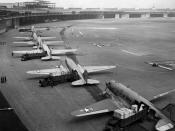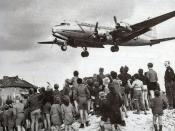Abstract
The Berlin Airlift, also known as Operation Vittles, was one of the most important events of the 20th century. At the end of the second world war, Germany's capital city of Berlin, as well as the rest of the country, had been divided up into sectors controlled by the four major powers: the United States, Britain, France, and the Soviet Union. The Soviet Union wanted all foreign and non-communist powers out of Berlin. In an attempt to gain control over the city and population, the Soviet Union was willing to starve the population by cutting off all access to and from the western sectors of the city (D.M. Giangreco and Robert E.Griffin, 1988). The United States, Britain, and France were determined not to let the western sectors come under Soviet jurisdiction. This meant a major effort in planning, cooperation, and logistical management between all three major powers.
With the roads closed, air transport into Berlin became critical. However, the United States and Great Britain was not sure about the success and feasibility of supplying Berlin's population of two million by air transport alone. They barely had enough personnel and equipment to accomplish its normal day-to-day operations.
I will analyze the events, people, equipment, and some the other contributing factors that made the Berlin Airlift a success and the biggest airlift in the history of aviation.
Berlin Airlift
Nearly sixty years have passed since the air forces of the United States and Great Britain united to bring food, hope, and freedom to people of West Berlin under the oppression of Stalin's Soviet Union. World War II had just ended and there was an opinion that there were not any other enemies or armies left to fight. The United States Army and United States Air Force had just separated...


